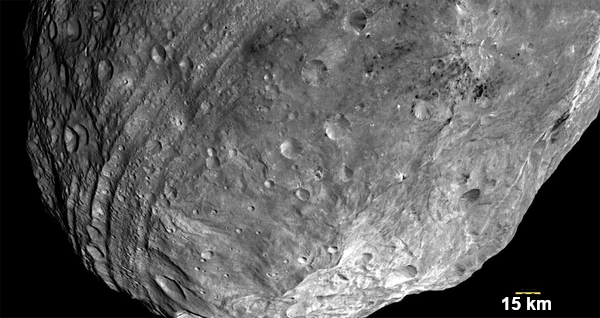
| Characteristic | Value |
|---|---|
| Mean Diameter | 525 km (578 × 560 × 458 km) |
| Volume | \(2.6 \times 10^{7}\ \text{km}^3\) |
| Mass | \(2.59 \times 10^{20}\ \text{kg}\) |
| Mean Density | 3.456 g/cm³ |
| Surface Gravity | \(0.25\ \text{m/s}^2\) vs \(9.81\ \text{m/s}^2\) on Earth ⇒ 70 kg ∼ 1.8 kg |
| Rotation Period | 5.34 hours |
| Orbital Inclination | 7.14° |
| Orbital Eccentricity | 0.089 |
| Mean Distance from the Sun | 2.36 AU |
| Spectral Type | V (basaltic) i.e., the surface is rich in volcanic igneous rocks |
| Discovery Date | March 29, 1807 |
Discovered in 1807 by Heinrich Olbers (1758-1840), the asteroid Vesta is a remarkable relic from the early Solar System. With a diameter of 525 km, it is the second-largest body in the main belt after Ceres. However, what intrigues scientists is its south pole: a gigantic excavation nearly 500 km wide, called the Rheasilvia basin, occupies almost the entire southern hemisphere.
This structure was revealed in detail by the Dawn probe (NASA) in 2011. The Rheasilvia basin, 19 km deep, is the result of an impact of rare violence that occurred about 1 billion years ago. The energy released by the collision is estimated at several million megatons, which could have completely destroyed a less massive body than Vesta.
At the center of the Rheasilvia basin stands an impressive dome: a mountain 22 km high, almost three times the height of Everest! This central peak results from the elastic rebound of the crust after the impact. This phenomenon, typical of large craters, informs us about the internal rheology of the parent body.
Numerical modeling of the basin shows that the impact penetrated the basaltic crust to affect the underlying silicate mantle. Vesta, unlike most asteroids, is a differentiated body, possessing a metallic core, a mantle, and a crust, similar to terrestrial planets.
The NASA video shows the rotation of Vesta. The 530 km diameter asteroid rotates on itself in 5 hours and 20 minutes. You can notice the amazing stripes that go around Vesta.
Around the Rheasilvia impact basin, vast linear stripes and fractures run across the surface of Vesta, forming an almost circular network that surrounds the south pole. These streaks, called grabens, result from the extreme mechanical stresses generated by the colossal impact that tore this region apart.
Physically, these stripes correspond to extensional faults, where the crust cracked and subsided under the effect of tensile forces. Their concentric orientation reflects the deformation of Vesta's rigid lithosphere after the impact, allowing the accumulated energy to be released.
The width of these grabens can reach several hundred meters, and their depth can exceed 1 km. Spectroscopic study shows that these areas expose deeper materials, providing natural access to the internal stratification of Vesta. This phenomenon thus testifies to the post-impact dynamics and the rheological behavior of the mantle and crust.
The presence of these stripes around the south pole is unique among known asteroids, making Vesta an exceptional natural laboratory for understanding the mechanical effects of giant impacts on medium-sized differentiated bodies. Their analysis also provides valuable clues about the distribution of internal stresses and the mechanical strength of the basaltic crust.
The impact ejected enormous amounts of debris into space, some of which reached Earth. Indeed, several eucrites, diogenites, and howardites (meteorite rocks) analyzed on Earth were formed on Vesta: they are grouped under the acronym HED. Their mineralogical composition confirms the link with the Vestoian soil.
These meteorites reveal ancient volcanic activity, confirmed by radiometric dating: Vesta underwent complete thermal differentiation 4.5 billion years ago, shortly after the formation of the Solar System. This body thus serves as a geological window into that primitive era.
The Rheasilvia basin is unlike any other feature in the belt. While most asteroids are loosely bound aggregates (rubble piles), Vesta retains a dense and cohesive internal structure, a remnant of a large protoplanet. It may be a planetary embryo that escaped accretion.
Vesta's almost spherical shape, its composition, and the presence of differentiated layers suggest that this body underwent partial or complete melting in its youth before cooling. Its torn south pole is the visible scar of a tumultuous history, preserved on a body that could have become a planet.
The gigantic excavation at Vesta's south pole testifies to an ancient cataclysm and an aborted planetary history. This celestial body, halfway between an asteroid and a planet, sheds light on the early stages of planet formation in the inner Solar System.